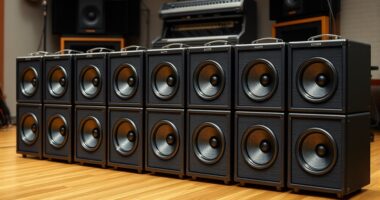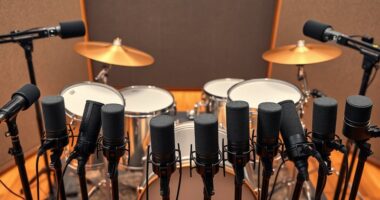If you’re looking for the 13 best flat-response studio monitors for accurate sound in 2025, I can help. I’ve reviewed models like the Yamaha HS4, Rockville DPM5C, and Ortizan C7, which deliver precise, balanced audio across a wide range. These monitors are ideal for mixing, mastering, or critical listening, featuring sturdy build quality and versatile connectivity. Keep exploring, and you’ll discover detailed insights to help you choose the perfect monitors for your setup.
Key Takeaways
- Highlight monitors with a flat frequency response from 33 Hz to 25 kHz for accurate sound reproduction.
- Prioritize models with durable build quality, internal resonance suppression, and high-grade components for long-term reliability.
- Consider monitors offering multiple connectivity options like XLR, TRS, RCA, and Bluetooth for versatile setup.
- Focus on devices designed for professional mixing, mastering, or critical listening in small to medium studio environments.
- Review user feedback and expert ratings to identify the top-performing flat-response monitors available in 2025.
Ortizan C7 Dual-Mode Studio Monitors (Pair, Black)

If you’re looking for studio monitors that deliver versatile connectivity and crystal-clear sound, the Ortizan C7 Dual-Mode Studio Monitors are an excellent choice. They offer multiple input options, including RCA, 3.5mm AUX, Bluetooth 5.3, and a 6.35mm TRS, making them adaptable for various setups. With a 24-bit DAC and high-quality drivers—a 3.5-inch carbon fiber mid-bass and a silk dome tweeter—they produce precise, balanced audio. Designed for clarity and accuracy, these monitors are perfect for content creators, musicians, and audiophiles alike. Their sleek black finish and professional tuning ensure both performance and aesthetic appeal in any environment.
Best For: content creators, musicians, and audiophiles seeking versatile, high-fidelity studio monitors for professional or casual use.
Pros:
- Multiple input options including RCA, AUX, Bluetooth 5.3, and TRS for flexible connectivity.
- High-quality sound with a 24-bit DAC, carbon fiber mid-bass, and silk dome tweeter for balanced audio.
- Sleek black design with professional tuning suitable for various environments.
Cons:
- May require space for proper placement due to their size.
- Limited bass response given the 3.5-inch driver, which might not satisfy bass-heavy preferences.
- Bluetooth pairing, while quick, can occasionally experience connectivity issues in crowded environments.
Rockville DPM5C 150W 5.25″ 2-Way Studio Monitor Speaker
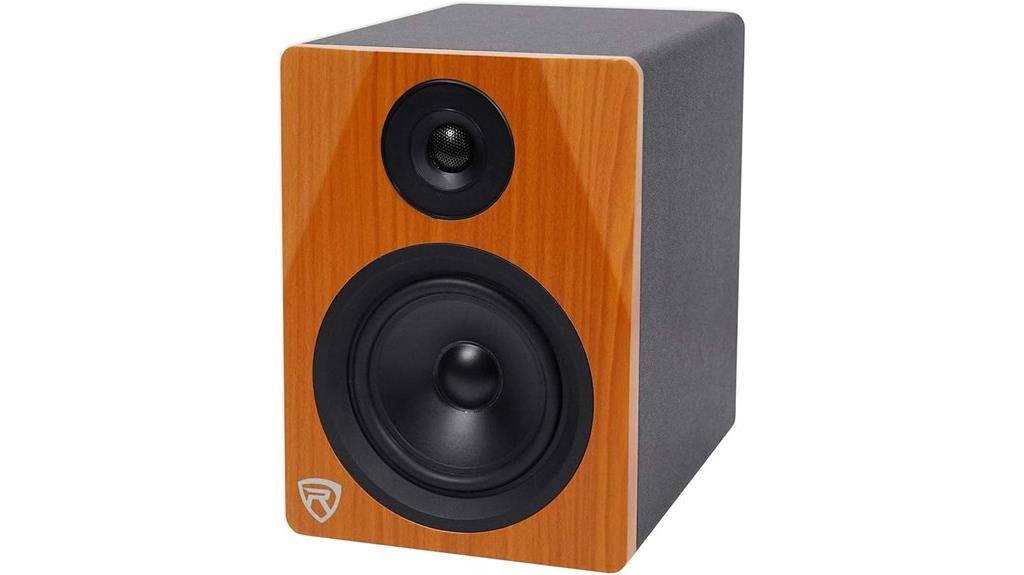
The Rockville DPM5C 150W 5.25″ 2-Way Studio Monitor Speaker stands out as an excellent choice for home studio owners and multimedia creators seeking precise, balanced sound. Its bi-amped design delivers 75W RMS, ensuring clear highs and deep lows across 55Hz–20kHz. The injection-molded polypropylene cone woofer and silk dome tweeter provide crisp, accurate response, while the curved bezel minimizes distortion. Built with a durable MDF enclosure and multiple input options—XLR, TRS, RCA—it integrates seamlessly with various devices. Thanks to its high-quality components and rigorous testing, it offers reliable, distortion-free playback at high volumes, making it a versatile, valuable addition to any setup.
Best For: Home studio owners, multimedia creators, and musicians seeking accurate, high-quality sound reproduction for mixing, mastering, gaming, or multimedia applications.
Pros:
- Delivers clear, balanced sound across 55Hz–20kHz with distortion-free performance at high volumes
- Durable MDF enclosure with high-quality components ensures long-term reliability
- Multiple input options (XLR, TRS, RCA) allow seamless integration with various devices
Cons:
- Only suitable for indoor use due to size and design
- Requires an external power source and proper positioning for optimal sound
- Limited to 5.25-inch woofer, which may not satisfy those needing deeper bass for certain applications
Gemini Sound SMX-3BT Bluetooth Bookshelf Studio Monitor Speakers

For those seeking versatile, budget-friendly studio monitors with Bluetooth convenience, the Gemini Sound SMX-3BT stands out as an excellent choice. These compact speakers deliver 100W peak power with a sleek wooden cabinet, fitting easily into home studios or bookshelf setups. They offer multiple input options—Bluetooth, RCA, TRS, and auxiliary—making device compatibility simple. The sound is clear and balanced across frequencies, with built-in EQ controls for environment tuning. Despite their small size, they produce robust sound suitable for various genres, though bass could be limited for bass-heavy music. Overall, they’re an affordable, user-friendly option for casual listening and light production.
Best For: casual music listeners, home studio enthusiasts, and budget-conscious users seeking versatile bookshelf speakers with Bluetooth connectivity.
Pros:
- Affordable price point under $100 offering good value for entry-level audio needs
- Multiple input options including Bluetooth, RCA, TRS, and auxiliary for versatile device compatibility
- Compact and stylish design that fits well into various indoor environments
Cons:
- Limited bass response, which may not satisfy bass-heavy genre enthusiasts
- Possible sound distortion at high volumes, affecting audio clarity in larger spaces
- Tight volume control that may be difficult to adjust smoothly for some users
PreSonus Eris 3.5 Studio Monitors, Pair
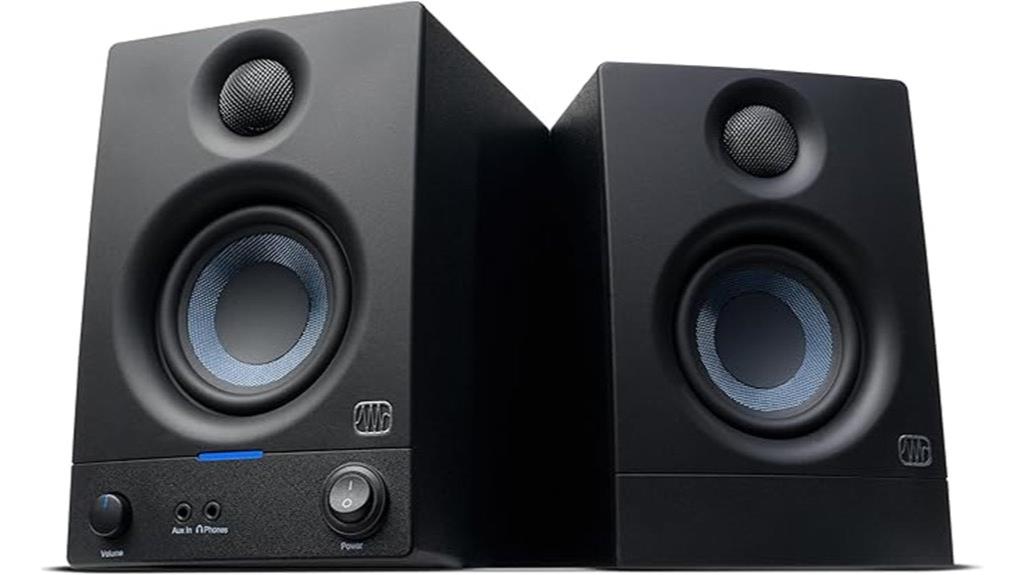
Designed for desktop producers and audiophiles alike, the PreSonus Eris 3.5 Studio Monitors deliver accurate, studio-quality sound in a compact package. They feature woven-composite woofers that produce tight bass and a robust low end, paired with 1-inch silk-dome tweeters for natural high frequencies. With 50 Watts of Class AB dual amplification, they offer plenty of power without losing tonal clarity. Their versatile inputs include TRS, RCA, and a front aux jack, along with adjustable high- and low-frequency controls. The front headphone output adds convenience, making them ideal for near-field setups, multimedia, and professional audio work.
Best For: desktop producers, audiophiles, and multimedia enthusiasts seeking accurate, compact studio monitoring with versatile connectivity.
Pros:
- Deliver studio-quality, accurate sound with tight bass and natural highs
- Compact design suitable for desktop, bookshelf, or near-field setups
- Multiple input options (TRS, RCA, aux) and adjustable frequency controls
Cons:
- Limited power output for large or very loud spaces
- No built-in Bluetooth or wireless connectivity options
- May require additional acoustic treatment for optimal sound in certain environments
Yamaha HS4 Powered Studio Monitor in Black, Pair (HS4 B)
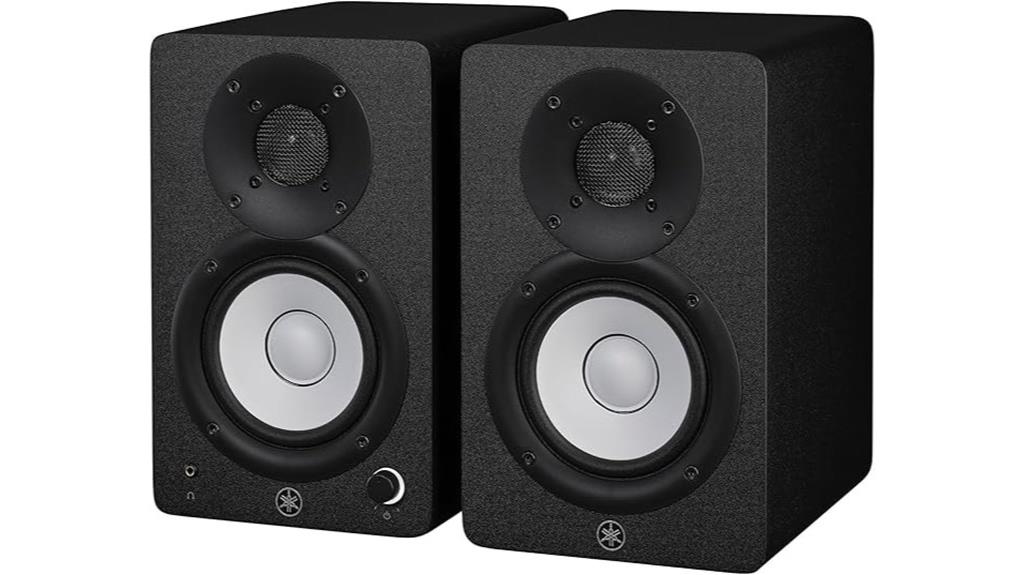
If you’re seeking reliable studio monitors that deliver precise, flat-response sound, the Yamaha HS4 Powered Studio Monitor in Black is an excellent choice. Designed for both professionals and casual users, these compact speakers feature a 4.5-inch bass-reflex driver and a dome tweeter, providing clear highs, balanced mids, and tight bass. They’re easy to set up with plug-and-play XLR/TRS and RCA inputs, and include anti-slip pads for stability. With a sturdy build and a neutral sound profile, they’re ideal for mixing, editing, or critical listening in small rooms. Users praise their transparency, durability, and value, making them a top contender in 2025’s studio monitor lineup.
Best For: musicians, producers, and audiophiles seeking accurate, high-fidelity studio monitors for mixing, editing, and casual listening in small to medium-sized rooms.
Pros:
- Accurate, flat-response sound profile ideal for professional mixing and critical listening
- Easy to set up with plug-and-play XLR/TRS and RCA inputs, plus included accessories
- Durable build quality with a sleek, professional aesthetic and stable anti-slip pads
Cons:
- Lacks deep bass; may require pairing with a subwoofer for full-range sound
- Optimal performance at medium to medium-high volumes; low volumes can lack bass, high volumes may cause distortion
- Designed primarily for small spaces; less suitable for large rooms or outdoor use
Rockville DPM5C Studio Monitor Speaker (150W, 5.25″)
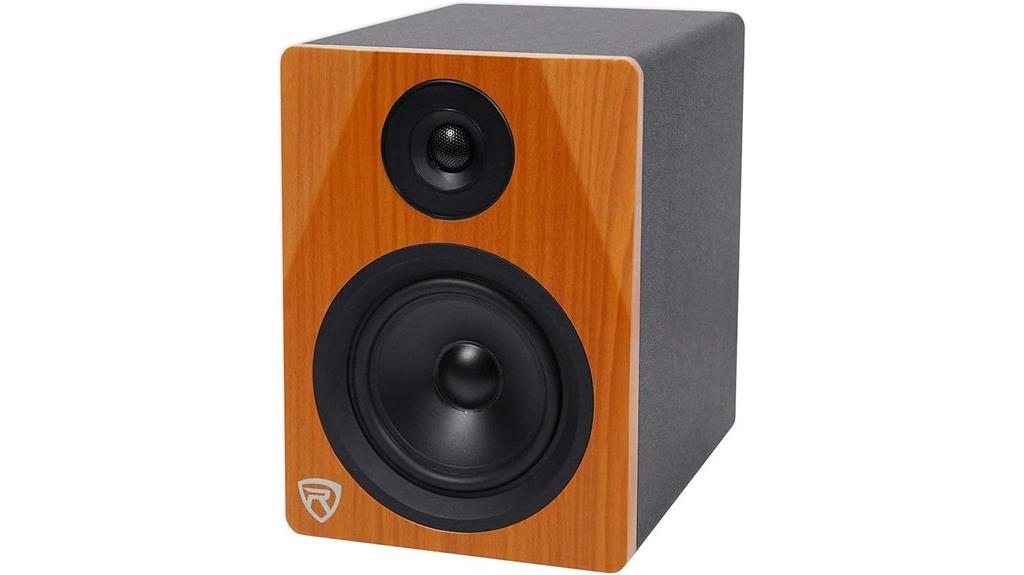
The Rockville DPM5C Studio Monitor Speaker stands out as an excellent choice for home studios, gaming setups, and multimedia enthusiasts seeking accurate and balanced sound. Its 150W peak power and 5.25″ woofer deliver clear, distortion-free audio across 55Hz–20kHz, thanks to a bi-amped design and computer-optimized crossover. The curved bezel minimizes standing wave distortion, while the injection-molded polypropylene cone and silk dome tweeter ensure crisp highs and robust lows. Connectivity options like XLR, TRS, and RCA make it versatile for various devices. Built with durable MDF and undergoes rigorous quality checks, making it a reliable, high-value monitor for precise sound reproduction.
Best For: Home studio producers, gamers, and multimedia enthusiasts seeking accurate, high-fidelity sound in a compact, durable monitor.
Pros:
- Delivers clear, distortion-free audio with balanced high and low frequencies
- Versatile connectivity options including XLR, TRS, and RCA inputs
- Durable MDF enclosure with quality craftsmanship and rigorous testing
Cons:
- May require external volume control or amplification for larger setups
- Size and weight might be less ideal for portable use or limited space
- Limited to indoor use, not suitable for outdoor environments
PreSonus Eris E5 2-Way 5.25 Near Field Studio Monitor

For musicians and audio professionals seeking precise sound reproduction, the PreSonus Eris E5 stands out as an excellent choice due to its professional-grade features and customizable tuning options. Its 5.25-inch woven composite woofer delivers solid low-end with minimal distortion, while the 1-inch silk-dome tweeter provides balanced high frequencies. With 80-watt Class AB bi-amplification, it offers ample volume and headroom. The acoustic tuning controls let you adjust the sound to your room, ensuring accuracy. Compatibility with XLR, TRS, and RCA inputs makes it versatile for various setups. Overall, the Eris E5 offers transparent, detailed sound—ideal for mixing, recording, and multimedia applications.
Best For: audio professionals, musicians, and home studio enthusiasts seeking accurate, professional-grade nearfield monitoring for mixing, recording, and multimedia use.
Pros:
- Professional-quality sound with clear, detailed imaging and a solid low end
- Adjustable acoustic tuning controls for room-specific calibration
- Versatile connectivity options including XLR, TRS, and RCA inputs
Cons:
- Size and bulkiness may require significant space on a desk or setup area
- Out-of-the-box sound may be slightly hyped or scooped, requiring tuning for flat response
- Individual power connections and setup complexity can be less convenient for quick setups
PreSonus Eris Studio 5 5.25-inch 2-Way Active Studio Monitors
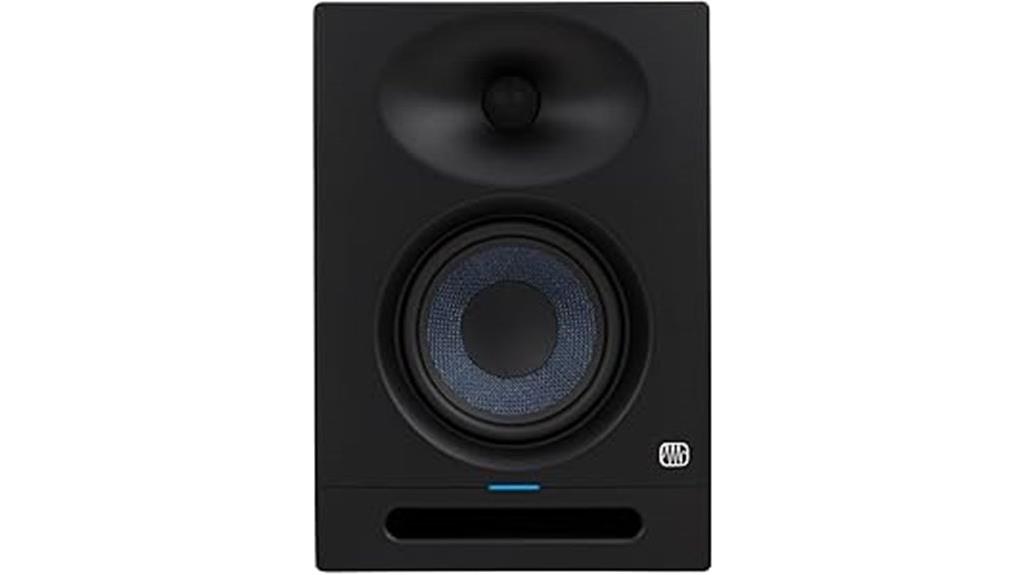
Designed for professional audio production, the PreSonus Eris Studio 5 monitors deliver accurate sound reproduction with high-quality components that guarantee clarity across the entire frequency spectrum. They feature a 5.25-inch woven-composite low-frequency driver that produces smooth, powerful bass with extended low end, complemented by a 1-inch silk-dome high-frequency transducer for natural, detailed highs. The custom-tuned waveguide provides a wide sweet spot, improving stereo imaging and spatial clarity. An front-firing acoustic port enhances bass response, while internal resonance-suppressing bracing ensures sound clarity. With 80W biamplification, these monitors deliver up to 102 dB SPL, maintaining tonal balance even at high volumes.
Best For: professional music producers and audio engineers seeking accurate, high-quality studio monitors for precise sound reproduction.
Pros:
- Clear and balanced sound across the entire frequency spectrum
- Wide stereo imaging with custom-tuned waveguide for an expansive sweet spot
- Powerful 80W biamplification ensuring high volume without distortion
Cons:
- May be more expensive than entry-level monitors for casual users
- Slightly larger footprint requiring ample space on your setup
- Limited low-end extension beyond 48 Hz without subwoofer support
KRK Kreate 3 Powered Studio Monitors Pair
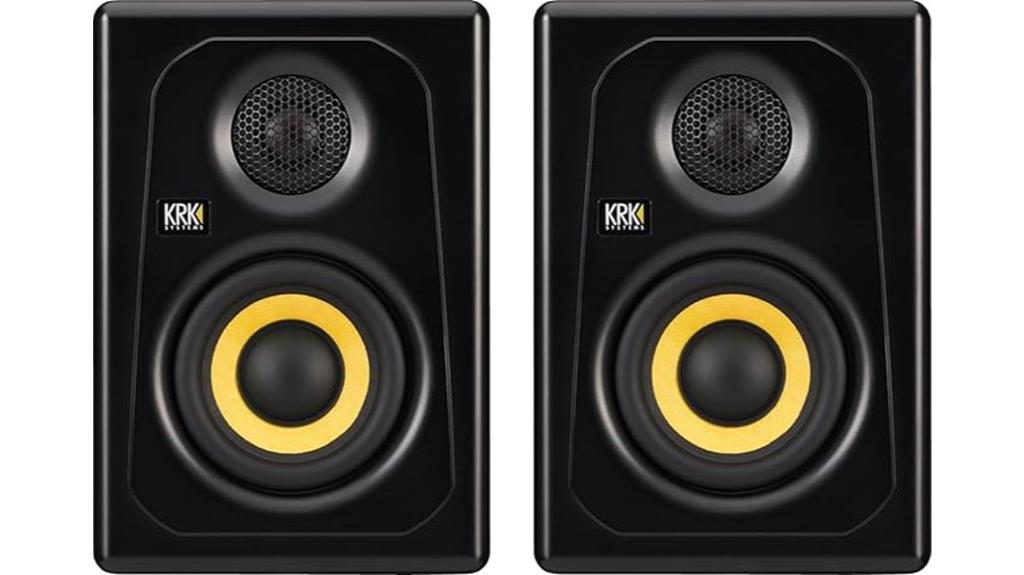
If you’re seeking studio monitors that deliver high-quality sound with wireless convenience, the KRK Kreate 3 Powered Studio Monitors Pair stands out. They feature a 3.5” Glass Aramid Woofer that provides clear midrange and tight bass, complemented by a textile dome tweeter for pristine high frequencies. The lightweight woven glass fiber composite woofer enhances sound clarity, making them ideal for professional studio use. Plus, with Bluetooth connectivity, you can stream audio wirelessly, and multiple inputs ensure versatile setup options. These monitors combine accurate sound reproduction with modern convenience, making them a solid choice for both mixing and casual listening.
Best For: musicians, producers, and audio enthusiasts seeking high-quality studio monitors with wireless streaming capabilities for professional and casual use.
Pros:
- Clear midrange and tight bass from the 3.5” Glass Aramid Woofer
- Wireless streaming via Bluetooth for added convenience
- Versatile connectivity with multiple audio inputs
Cons:
- Compact size may limit bass extension for some users
- May require additional room treatment for optimal sound in larger spaces
- Premium price point compared to basic monitors
ADAM Audio T8V Studio Monitor
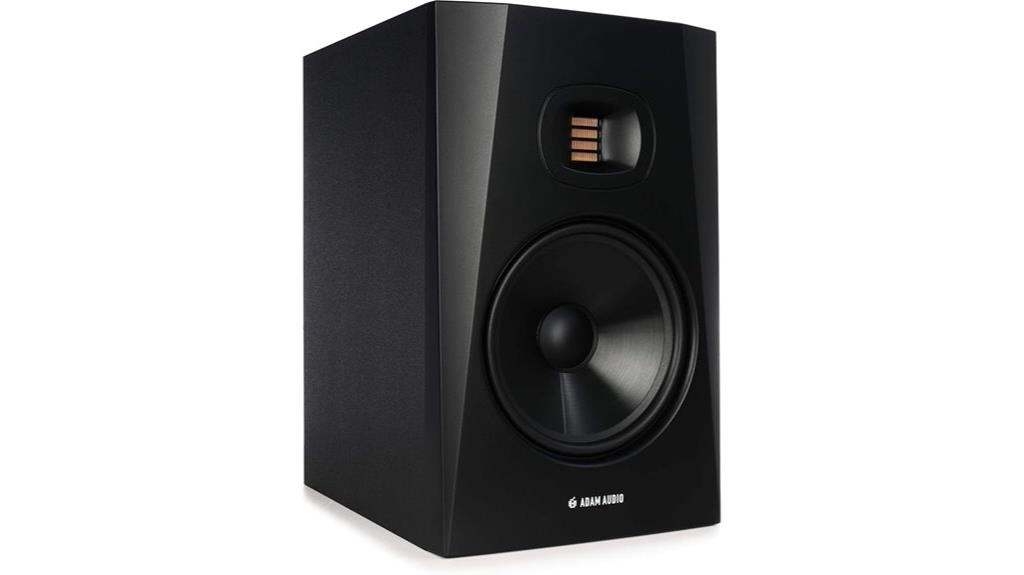
The ADAM Audio T8V Studio Monitor stands out for its powerful bass response and high-frequency clarity, making it an excellent choice for professionals working with bass-heavy genres or requiring detailed sound reproduction. Its advanced technology delivers a deep bass extension down to 33 Hz, perfect for EDM, hip-hop, and film scoring. The iconic tweeter reaches up to 25 kHz, reducing ear fatigue and distortion during long sessions. The HPS Waveguide technology broadens the sweet spot, providing a more flexible listening environment without sacrificing sound quality. Overall, the T8V combines high power, extended bass, and clarity for accurate, studio-quality monitoring.
Best For: audio professionals and producers who need powerful bass, detailed high frequencies, and a wide listening sweet spot for bass-heavy genres, film scoring, and mixing.
Pros:
- Deep bass extension down to 33 Hz for bass-heavy music production
- High-frequency clarity up to 25 kHz reduces ear fatigue and distortion
- HPS Waveguide technology creates a wider, more controlled listening area
Cons:
- May be more expensive than entry-level monitors for casual users
- Larger size might require more space in smaller studios
- Requires proper positioning to maximize the wide sweet spot feature
Ortizan C7 Dual-Mode 2.0 Studio Monitors
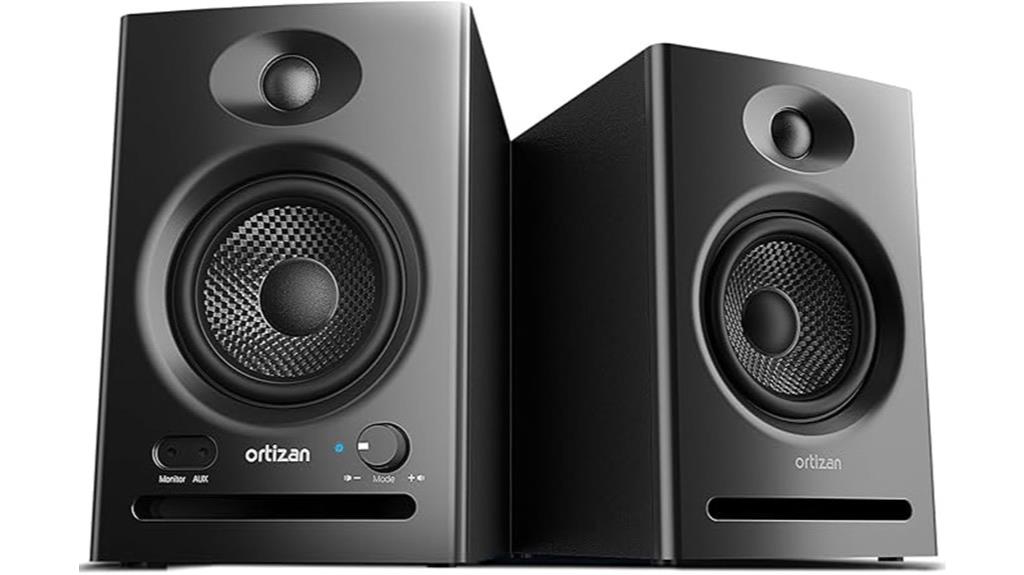
For those seeking versatile studio monitors that deliver accurate sound across various applications, the Ortizan C7 Dual-Mode 2.0 stands out with its multiple input options and seamless connectivity. It offers RCA inputs for lossless TV connections, a 3.5mm AUX for headphones or portable devices, and Bluetooth 5.3 for quick wireless pairing with smartphones or tablets. The 6.35mm TRS input supports professional gear like mixers and guitars, making it suitable for music production. Featuring a 24-bit DAC, a 3.5-inch carbon fiber mid-bass, and a silk dome tweeter, these monitors produce clear, balanced sound. Their sleek design and variety of inputs make them ideal for both casual and professional use.
Best For: musicians, content creators, and home entertainment enthusiasts seeking versatile, high-fidelity studio monitors with multiple connectivity options.
Pros:
- Multiple input options including RCA, 3.5mm AUX, Bluetooth 5.3, and 6.35mm TRS for flexible setup
- High-quality sound with a 24-bit DAC, precision mid-bass, and smooth highs for accurate audio reproduction
- Compact and sleek design suitable for professional and casual environments
Cons:
- May require additional equipment for optimal professional studio use
- Limited to 3.5-inch speakers, which might not satisfy those needing larger, more powerful monitors
- Bluetooth connection, while quick, may introduce slight latency in some use cases
Edifier MR3 Powered Studio Monitor Speakers

Edifier MR3 Powered Studio Monitor Speakers stand out as a versatile choice for those seeking accurate sound reproduction in a compact, stylish package. These Hi-Res Audio Certified speakers deliver full-range audio with clear mids and highs, rich bass, and a flat response from 52Hz to 40kHz. They support multiple inputs including Bluetooth V5.4, RCA, TRS, and AUX, making them flexible for various setups. With 18W RMS per channel, they provide powerful sound suitable for gaming, video editing, or casual listening. The MDF cabinet minimizes distortion, and user-friendly controls allow easy tuning of bass and treble. Overall, they combine quality, convenience, and style at a great price.
Best For: casual music listeners, gamers, and video editors seeking versatile, stylish desktop speakers with rich sound and multiple connectivity options.
Pros:
- Supports multiple inputs including Bluetooth V5.4, RCA, TRS, and AUX for flexible setup
- Delivers powerful 18W RMS per channel with full-range sound and rich bass
- User-friendly controls for easy tuning of bass, treble, and sound effects
Cons:
- Occasional light distortion or crackling, especially in mids and highs
- Some users report issues with LED indicator durability and potential early failure
- Not waterproof or suitable for outdoor use, limited to stationary indoor environments
Mackie CR3.5 3.5-inch Powered Studio Monitors
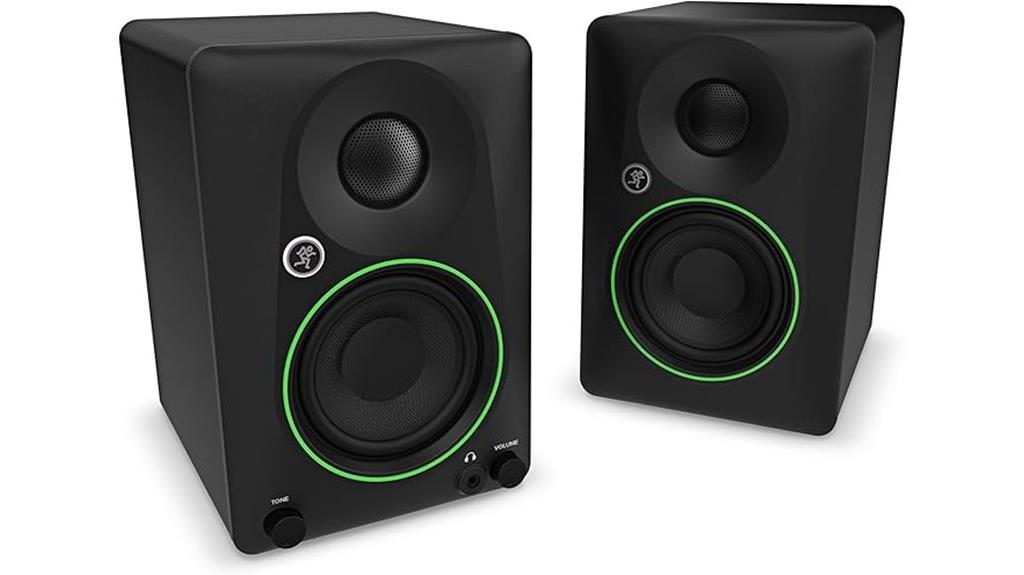
If you need compact studio monitors that deliver professional-quality sound without breaking the bank, the Mackie CR3.5 stands out as an excellent choice. These powered monitors feature a versatile design with RCA and TRS inputs, switchable desktop and bookshelf modes, and a tone control knob for sound shaping. The 3.5-inch speaker and 1-inch tweeter produce clear, balanced highs, mids, and surprisingly solid bass for their size. They’re easy to set up with included cables and foam isolation pads, and their sleek build fits well on any desk. Overall, they offer great value for home studios, multimedia, or casual listening.
Best For: home studio enthusiasts, content creators, and casual listeners seeking compact, high-quality studio monitors at an affordable price.
Pros:
- Delivers professional-quality sound with clear highs, mids, and solid bass for its size
- Versatile inputs (RCA and TRS) and switchable desktop/ bookshelf modes for flexible setup
- Easy to set up with included cables, foam pads, and a sleek, durable design
Cons:
- Limited to wired connections; lacks Bluetooth or wireless options
- Clipping may occur at maximum volume, potentially affecting sound quality
- Tone control is somewhat optional and may be considered a gimmick by some users
Factors to Consider When Choosing Flat‑Response Studio Monitors
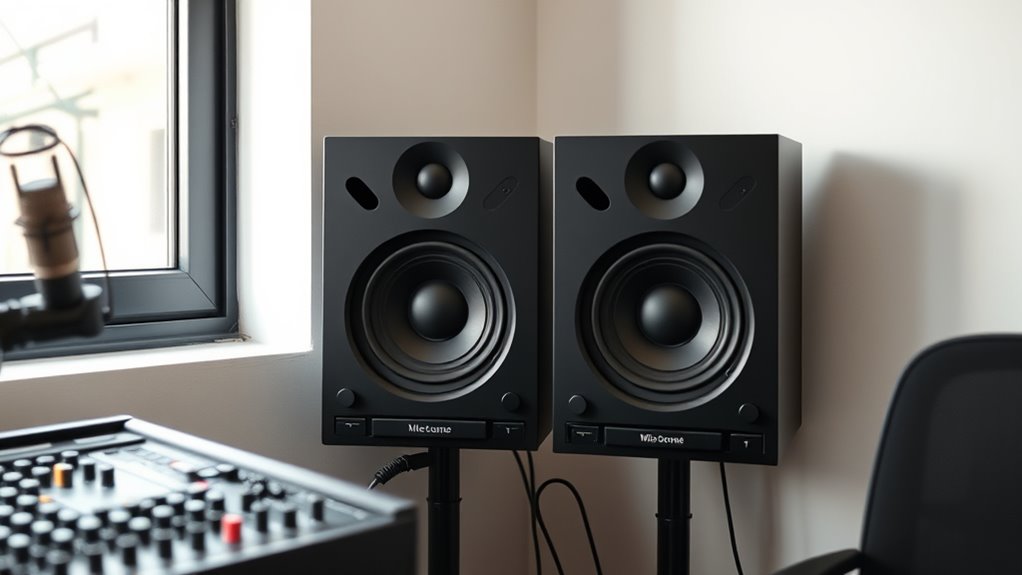
When choosing flat-response studio monitors, I consider several key factors to guarantee I get the best sound. The frequency range accuracy, sound clarity, room size compatibility, power needs, and connectivity options all play vital roles in making the right choice. Keeping these points in mind helps me find monitors that deliver precise, reliable performance for any studio environment.
Frequency Range Accuracy
Ensuring accurate frequency range response is essential when selecting flat-response studio monitors because it directly affects how faithfully they reproduce sound across the entire audible spectrum. A monitor’s frequency response typically spans from around 40 Hz to 20 kHz, capturing deep bass and high treble essential for precise mix decisions. Variations in response can cause certain frequencies to sound louder or softer than they should, misleading your perception of the mix. To assess a monitor’s accuracy, I analyze its response curve for deviations from a flat line, ensuring all frequencies are reproduced evenly. A flat response delivers a neutral, true-to-source sound profile, allowing me to make confident mixing and mastering choices without colorations or biases. This accuracy is indispensable for achieving professional-quality audio.
Sound Clarity and Detail
Sound clarity and detail are essential factors in selecting flat-response studio monitors because they determine how accurately I can perceive subtle nuances in the audio. High-fidelity monitors use precise drivers and electronic crossovers to deliver clear, detailed midrange and high-frequency sounds, revealing even the tiniest variations. Accurate sound clarity allows me to detect mic bleed, room reverb, or minute mix adjustments that could otherwise go unnoticed. Monitors with extended frequency response and low distortion levels provide a transparent, detailed audio presentation, ensuring no sonic information is lost. A flat, consistent frequency response across the spectrum lets me make informed mixing decisions without coloration, trusting that what I hear is true to the original recording. This level of detail is vital for professional accuracy.
Room Size Compatibility
Choosing the right flat-response studio monitors depends heavily on your room size, as each space presents unique acoustic challenges. Larger rooms need monitors with extended bass response and higher power output to fill the space without losing clarity. Smaller or treated rooms benefit from monitors that deliver a flat frequency response at lower volumes, preventing distortion and acoustic issues. Room dimensions and shape influence how sound waves interact, so selecting monitors suited to your space helps avoid standing waves or dead spots that skew your mix. Monitors with high maximum SPL ratings are ideal for larger rooms, providing clear sound at higher volumes. Proper placement combined with monitors that match your room size ensures balanced sound, giving you accurate, reliable results in your mixing environment.
Power and Headroom
When selecting flat-response studio monitors, paying attention to power and headroom is essential because inadequate power can lead to distortion and compromised sound quality at higher volumes. Adequate wattage guarantees the monitors produce clean, distortion-free sound without clipping, especially during dynamic peaks. Headroom, the difference between average operating levels and maximum capacity, prevents audio from distorting during loud passages. Monitors with higher RMS ratings generally offer greater headroom, allowing for louder playback without sacrificing sound fidelity. Failing to match monitor power with room size and listening needs can cause compression or a lack of dynamic range. Properly evaluating power and headroom helps maintain a flat frequency response and ensures clarity, accuracy, and consistency in your monitoring environment.
Connectivity Options
Selecting the right studio monitors involves considering their connectivity options, as these determine how easily they integrate with your audio setup. Most flat-response monitors come with multiple input types like XLR, TRS, RCA, and auxiliary jacks, providing flexibility for various devices. Balanced inputs such as XLR and TRS help reduce noise and interference, ensuring cleaner sound during critical mixing or mastering. Some models even offer wireless Bluetooth connectivity, allowing quick pairing with smartphones or tablets for casual listening or quick reference. The availability of multiple input options makes it simple to connect to audio interfaces, mixers, or professional equipment without hassle. Front panel inputs and controls can further streamline source switching and level adjustments, making your workflow more efficient and ensuring your monitors fit seamlessly into your studio environment.
Build Quality Durability
Building a set of reliable flat-response studio monitors starts with their construction quality, as durability directly impacts long-term performance. High-quality monitors use premium materials like MDF enclosures and reinforced components, ensuring they withstand physical wear and tear. Features such as rubber surrounds and reinforced drivers help maintain sound integrity over time, even after extensive use. Well-built monitors also incorporate internal bracing to minimize resonance and unwanted vibrations, which can distort sound accuracy. The use of high-grade components combined with meticulous manufacturing processes reduces the risk of electrical failures or physical deterioration. Additionally, durable monitors include heat dissipation features and sturdy external finishes that resist environmental factors and frequent handling. Investing in robust construction guarantees your monitors remain reliable and deliver consistent audio clarity for years to come.
Budget and Value
Choosing the right flat-response studio monitor involves balancing your budget with the need for accurate sound reproduction. Cheaper models might save you money upfront but can compromise the flat response essential for critical listening. High-value monitors often deliver professional tuning and quality components at a lower price, giving you better performance without overspending. Remember, price alone doesn’t guarantee flat response—focus on features like frequency range and tuning options that ensure precise sound. Budget-friendly options may lack room tuning controls or extended high frequencies, which can impact fidelity. Investing in monitors that offer good value helps avoid costly upgrades later, especially if they provide a true flat response from the start. Striking this balance ensures you get reliable, accurate sound without unnecessary expense.
Frequently Asked Questions
How Do Flat-Response Monitors Influence Mixing Accuracy?
Flat-response monitors help me mix more accurately because they deliver a true, uncolored sound without boosting or cutting specific frequencies. This honesty allows me to hear the mix as it truly is, making it easier to identify issues and make precise adjustments. When I use them, I trust the sound I hear, leading to better mixes that translate well across different listening environments.
Are Powered Monitors Better Than Passive for Studio Use?
Imagine a clear, crisp lake reflecting every detail—that’s what powered monitors deliver. I find powered monitors often better for studio use because they simplify setup, with built-in amplifiers providing cleaner, more consistent sound. They’re ideal if you want a straightforward, reliable option. Passive monitors require an external amp, which can introduce variables. For ease and precision, I prefer powered monitors—they’re like a direct, unfiltered reflection of your sound.
What Is the Ideal Room Size for Flat-Response Monitors?
The ideal room size for flat-response monitors is typically around 150 to 300 square feet. I find that a space this size helps minimize unwanted reflections and standing waves, ensuring accurate sound. Larger rooms can cause echo issues, while smaller spaces might lead to bass build-up. Proper treatment and positioning are also key, but a balanced room size makes a significant difference in getting true, flat sound.
How Important Is Speaker Placement for Flat-Response Accuracy?
Think of your speakers as the orchestra’s conductor — their placement directs the entire symphony of sound. I believe that proper positioning is vital for flat-response accuracy because it minimizes reflections and phase issues. I always experiment with angles and distances, aiming for a balanced, direct sound. When I get the placement right, it’s like tuning the orchestra perfectly — every note and nuance comes through crystal clear.
Do Flat-Response Monitors Require Special Calibration or Room Treatment?
Flat-response monitors don’t necessarily need special calibration or room treatment, but they do benefit from proper setup. I recommend placing them at ear level, equidistant from your listening position, and avoiding reflective surfaces. While room treatment isn’t mandatory, it can markedly improve sound accuracy by reducing reflections and standing waves. Ultimately, a well-balanced environment enhances flat-response monitors’ performance, giving you a truer, more reliable listening experience.
Conclusion
Choosing the right flat-response studio monitors is like finding the perfect pair of glasses—they reveal every detail with clarity. As you explore options from Ortizan to Mackie, remember that accuracy and transparency are key. Trust your ears and select a monitor that feels like an extension of your own voice. After all, in the world of sound, these monitors are your window to true, uncolored audio—your creative partner in every mix.


